操作系统实验
最佳拟合算法:最佳适配内存分配算法分配存储器中可用的最小空闲分区,
足以容纳系统内的进程。它在完整的内存中搜索可用的空闲分区,并将进程分配
到足够小的内存分区来保存进程。
思想: 总是把既能满足需求,又是最小的空闲分区分配给作业。
过程: 算法首先将所有空闲区按大小排序,以递增形式形成一个空白链,
每次找到的第一个满足需求的空闲区必然是最优的。
Bestfit 代码:
#include
int main()
{
int fragments[10], block[10], file[10], m, n, number_of_blocks, number_of_files, temp,
lowest = 10000;
static int block_arr[10], file_arr[10];
printf("\nEnter the Total Number of Blocks:\t");
scanf("%d", &number_of_blocks);
printf("\nEnter the Total Number of Files:\t");
scanf("%d", &number_of_files);
printf("\nEnter the Size of the Blocks:\n");
for (m = 0; m < number_of_blocks; m++)
{
}
printf("Block No.[%d]:\t", m + 1);
scanf("%d", &block[m]);
printf("Enter the Size of the Files:\n");
for (m = 0; m < number_of_files; m++)
{
}
printf("File No.[%d]:\t", m + 1);
scanf("%d", &file[m]);
for (m = 0; m < number_of_files; m++)
{
for (n = 0; n < number_of_blocks; n++)
�
if (block_arr[n] != 1)
{
}
temp = block[n] - file[m];
if (temp >= 0)
{
}
if (lowest > temp)
{
}
file_arr[m] = n;
lowest = temp;
fragments[m] = lowest;
{
}
block_arr[file_arr[m]] = 1;
lowest = 10000;
}
printf("\nFile Number\tFile Size\tBlock Number\tBlock Size\tFragment");
for (m = 0; m < number_of_files && block_arr[m] != 0; m++)
{
printf("\n%d\t\t%d\t\t%d\t\t%d\t\t%d", m, file[m], file_arr[m],
block[file_arr[m]], fragments[m]);
}
printf("\n");
return 0;
}
NextFit 算法:
思想:在分配内存块时,算法首先适合找到一个空闲分区。下一次调用该算
法时,将从停止的位置开始搜索,而不是从头开始搜索。
过程: 算法读取每个文件写入内存的位置,将下一个可用内存块分配给后
续进程。当一个进程被执行存储在内存中时,会检查前一个 bin 或内存块的可用
性。如果它是空闲的,那么一个进程被写入同一个内存块,否则,检查下一个块。
NextFit 代码:
#include
�
int main()
{
int memory_size[10][2], process_size[10][3];
int i, j, total_processes = 0, total_memory = 0;
printf("\nEnter the Total Number of Processes:\t");
scanf("%d", &total_processes);
printf("\nEnter the Size of Each Process\n");
for (int i = 0; i < total_processes; i++)
{
}
printf("Enter Size of Process %d:\t", i + 1);
scanf("%d", &process_size[i][0]);
process_size[i][1] = 0;
process_size[i][2] = i;
printf("\nEnter Total Memory Blocks:\t");
scanf("%d", &total_memory);
printf("\nEnter the Size of Each Block:\n");
for (i = 0; i < total_processes; i++)
{
}
printf("Enter Size of Block %d:\t", i + 1);
scanf("%d", &memory_size[i][0]);
memory_size[i][1] = 0;
for (i = 0; i < total_processes; i++)
{
while (j < total_memory)
{
if (memory_size[j][1] == 0 && process_size[i][0] <= memory_size[j][0])
{
process_size[i][1] = 1;
memory_size[j][1] = 1;
printf("\nProcess [%d] Allocated to Memory Block:\t%d", i + 1, j + 1);
break;
}
j++;
}
}
for (i = 0; i < total_memory; i++)
{
}
if (process_size[i][1] == 0)
{
}
printf("\nProcess [%d] Unallocated\n", i + 1);
�
printf("\n");
return 0;
}
FirstFit 算法:即第一个适合算法,第一个适合的内存分配算法分配内存中可
用的第一个可用分区,足以容纳系统内的进程。它不会检查所需的最小空间,而
是选择能够处理该进程的第一个遇到的分区。
思想:使用内存中低地址部分的空闲分区,在高地址部分的空闲分区非常少
被利用,从而保留了高地址部分的大空闲区。
过程:首先给出 5 个分区,以及 4 个文件,在分配内存时,从空闲分区开始
查找,真到找到满足其大小的分区为止,再按文件的大小从分区中划出一块内存
给请求者,如此循环。
FirstFit 代码:
#include
int main()
{
static int block_arr[10], file_arr[10];
int fragments[10], blocks[10], files[10];
int m, n, number_of_blocks, number_of_files, temp;
printf("\nEnter the Total Number of Blocks:\t");
scanf("%d", &number_of_blocks);
printf("Enter the Total Number of Files:\t");
scanf("%d", &number_of_files);
printf("\nEnter the Size of the Blocks:\n");
for (m = 0; m < number_of_blocks; m++)
{
}
printf("Block No.[%d]:\t", m + 1);
scanf("%d", &blocks[m]);
printf("Enter the Size of the Files:\n");
for (m = 0; m < number_of_files; m++)
{
}
printf("File No.[%d]:\t", m + 1);
scanf("%d", &files[m]);
for (m = 0; m < number_of_files; m++)
{
for (n = 0; n < number_of_blocks; n++)
�
{
}
if (block_arr[n] != 1)
{
}
temp = blocks[n] - files[m];
if (temp >= 0)
{
}
file_arr[m] = n;
break;
fragments[m] = temp;
block_arr[file_arr[m]] = 1;
}
printf("\nFile Number\tBlock Number\tFile Size\tBlock Size\tFragment");
for (m = 0; m < number_of_files; m++)
{
printf("\n%d\t\t%d\t\t%d\t\t%d\t\t%d", m, file_arr[m], files[m],
blocks[file_arr[m]], fragments[m]);
}
printf("\n");
return 0;
}
WorstFit 算法:最差的适应性内存分配算法分配内存中可用的最大空闲分区,
足以保存系统内的进程。
思想:算法按大小递减的顺序形成空闲区链,分配时直接从空闲区链的第一个空闲分
区中分配(不能满足需要则不分配)。
过程:分配内存时,算法首先搜索完整的内存以获得可用的空闲分区,然后
将进程分配给最大的内存分区
WorstFit 代码:
#include
int main()
{
int fragments[10], blocks[10], files[10];
int m, n, number_of_blocks, number_of_files, temp, top = 0;
static int block_arr[10], file_arr[10];
�
printf("\nEnter the Total Number of Blocks:\t");
scanf("%d", &number_of_blocks);
printf("Enter the Total Number of Files:\t");
scanf("%d", &number_of_files);
printf("\nEnter the Size of the Blocks:\n");
for (m = 0; m < number_of_blocks; m++)
{
}
printf("Block No.[%d]:\t", m + 1);
scanf("%d", &blocks[m]);
printf("Enter the Size of the Files:\n");
for (m = 0; m < number_of_files; m++)
{
}
printf("File No.[%d]:\t", m + 1);
scanf("%d", &files[m]);
for (m = 0; m < number_of_files; m++)
{
for (n = 0; n < number_of_blocks; n++)
{
if (block_arr[n] != 1)
{
}
temp = blocks[n] - files[m];
if (temp >= 0)
{
}
if (top < temp)
{
}
file_arr[m] = n;
top = temp;
fragments[m] = top;
block_arr[file_arr[m]] = 1;
top = 0;
}
}
printf("\nFile Number\tFile Size\tBlock Number\tBlock Size\tFragment");
for (m = 0; m < number_of_files; m++)
{
printf("\n%d\t\t%d\t\t%d\t\t%d\t\t%d", m, files[m], file_arr[m],
blocks[file_arr[m]], fragments[m]);
}
printf("\n");
�
return 0;
}
�
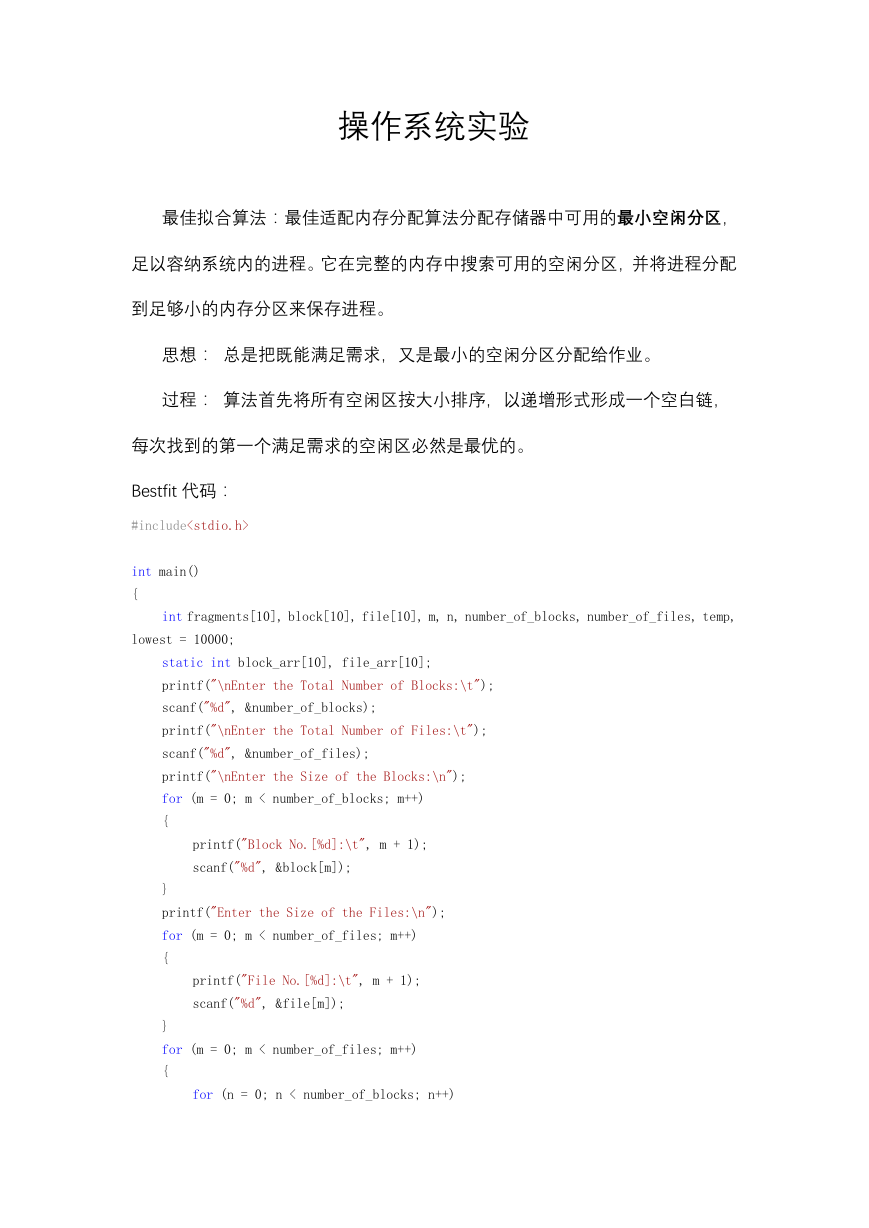
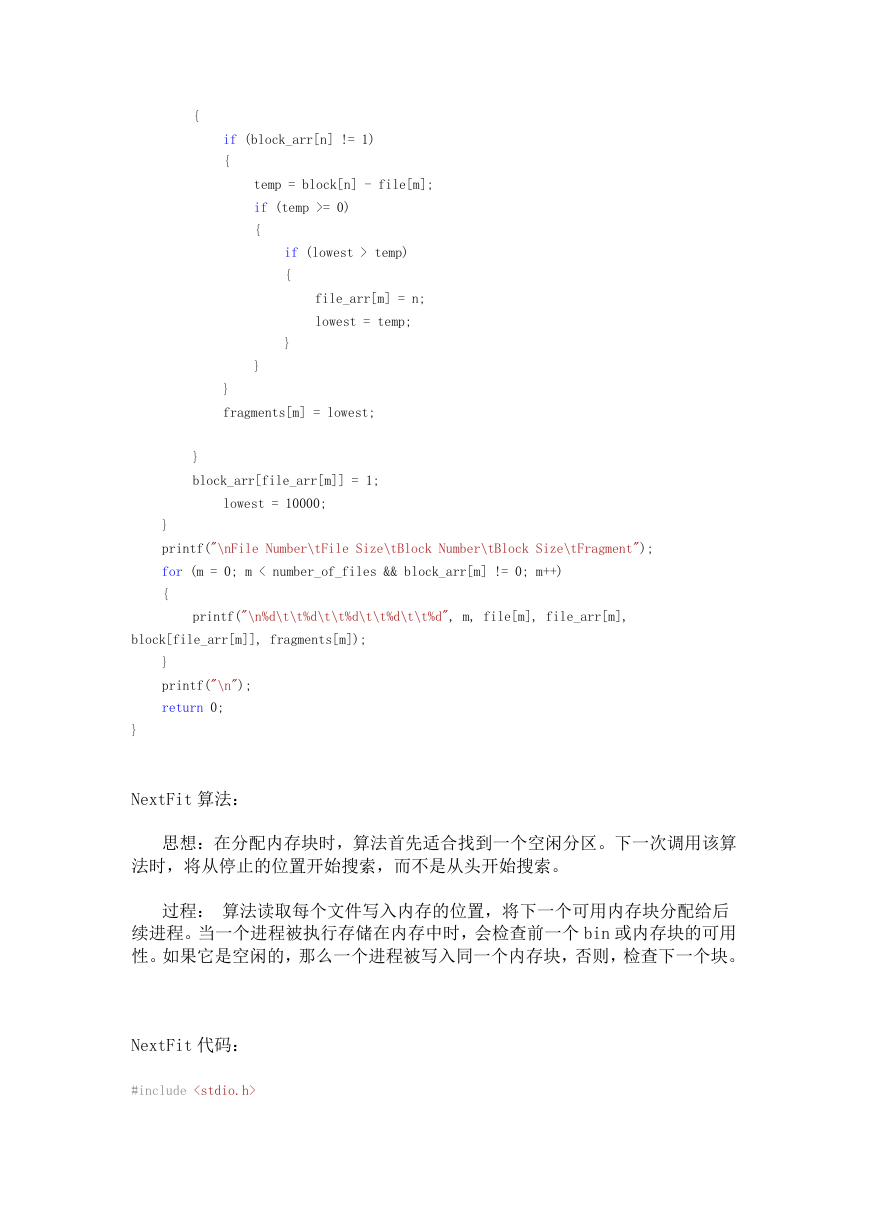
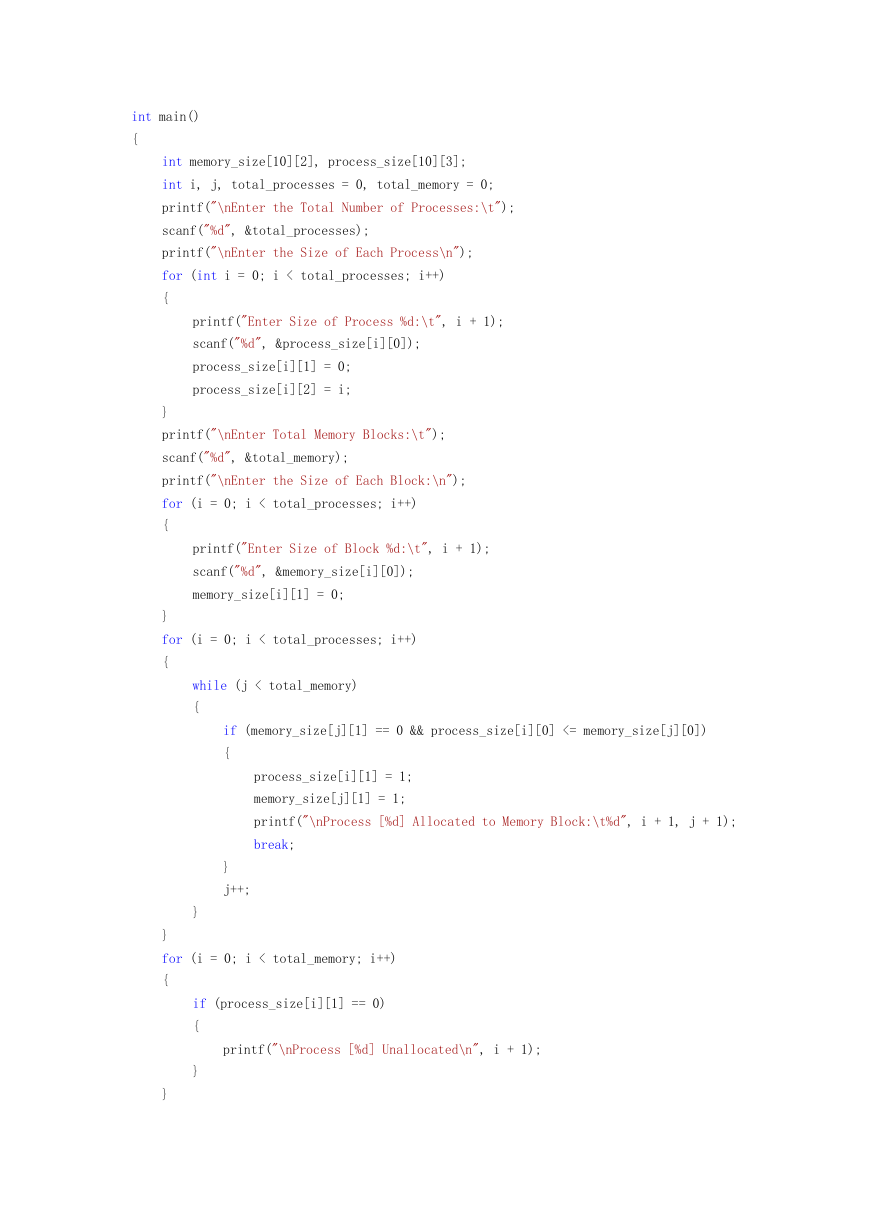
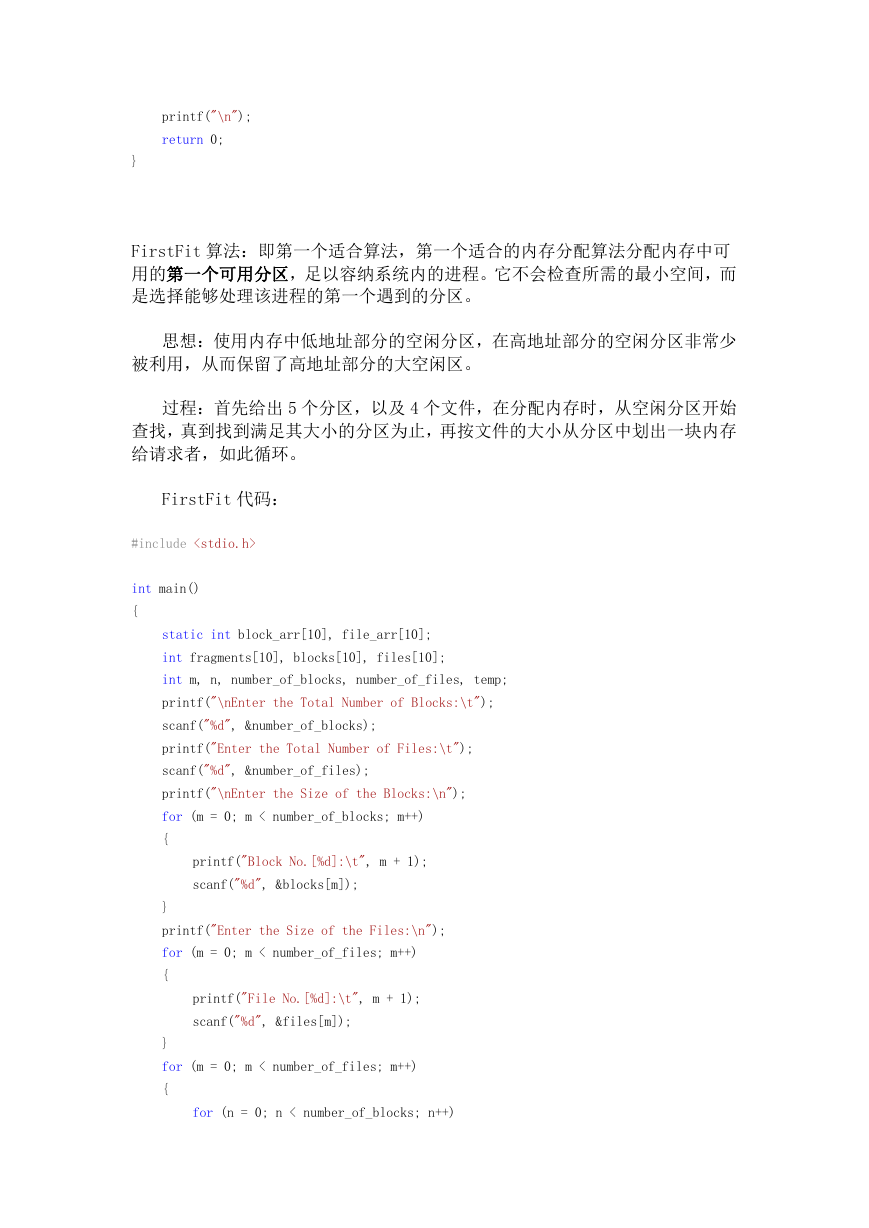
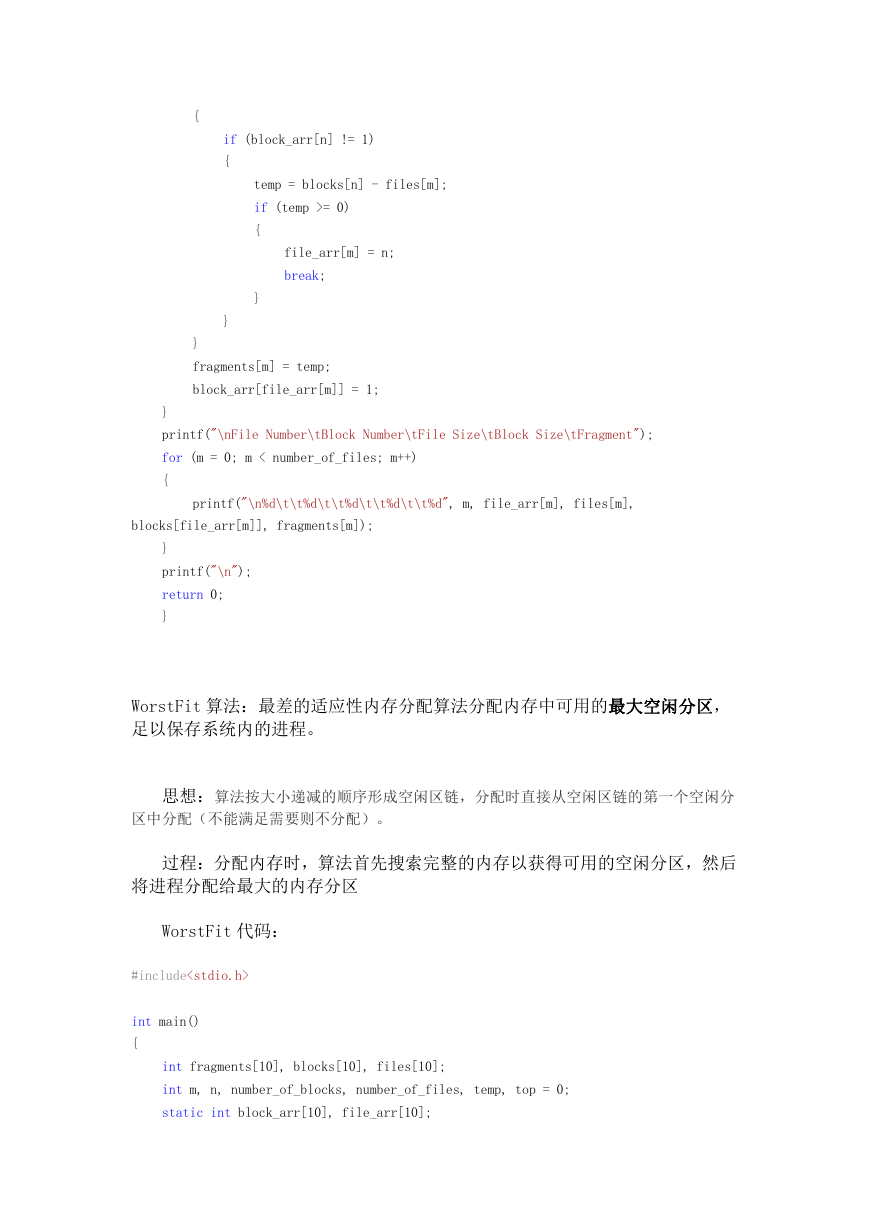









 2023年江西萍乡中考道德与法治真题及答案.doc
2023年江西萍乡中考道德与法治真题及答案.doc 2012年重庆南川中考生物真题及答案.doc
2012年重庆南川中考生物真题及答案.doc 2013年江西师范大学地理学综合及文艺理论基础考研真题.doc
2013年江西师范大学地理学综合及文艺理论基础考研真题.doc 2020年四川甘孜小升初语文真题及答案I卷.doc
2020年四川甘孜小升初语文真题及答案I卷.doc 2020年注册岩土工程师专业基础考试真题及答案.doc
2020年注册岩土工程师专业基础考试真题及答案.doc 2023-2024学年福建省厦门市九年级上学期数学月考试题及答案.doc
2023-2024学年福建省厦门市九年级上学期数学月考试题及答案.doc 2021-2022学年辽宁省沈阳市大东区九年级上学期语文期末试题及答案.doc
2021-2022学年辽宁省沈阳市大东区九年级上学期语文期末试题及答案.doc 2022-2023学年北京东城区初三第一学期物理期末试卷及答案.doc
2022-2023学年北京东城区初三第一学期物理期末试卷及答案.doc 2018上半年江西教师资格初中地理学科知识与教学能力真题及答案.doc
2018上半年江西教师资格初中地理学科知识与教学能力真题及答案.doc 2012年河北国家公务员申论考试真题及答案-省级.doc
2012年河北国家公务员申论考试真题及答案-省级.doc 2020-2021学年江苏省扬州市江都区邵樊片九年级上学期数学第一次质量检测试题及答案.doc
2020-2021学年江苏省扬州市江都区邵樊片九年级上学期数学第一次质量检测试题及答案.doc 2022下半年黑龙江教师资格证中学综合素质真题及答案.doc
2022下半年黑龙江教师资格证中学综合素质真题及答案.doc